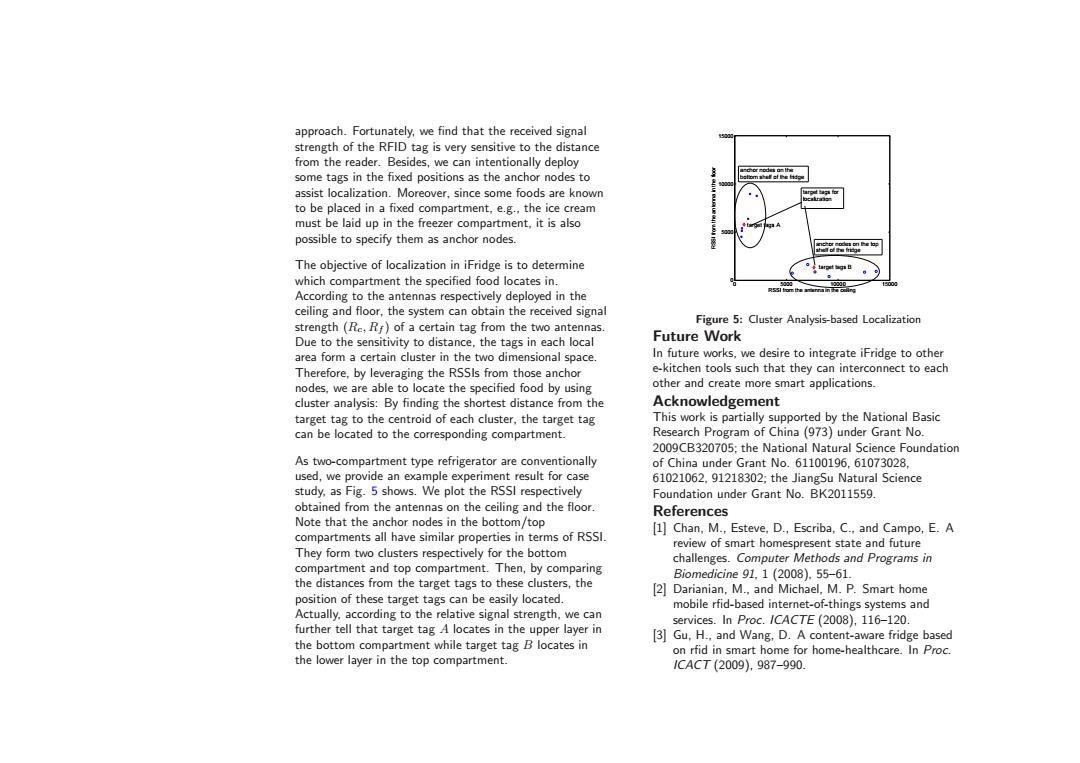正在加载图片...

approach.Fortunately,we find that the received signal strength of the RFID tag is very sensitive to the distance from the reader.Besides,we can intentionally deploy some tags in the fixed positions as the anchor nodes to assist localization.Moreover,since some foods are known to be placed in a fixed compartment,e.g.,the ice cream must be laid up in the freezer compartment,it is also possible to specify them as anchor nodes. The objective of localization in iFridge is to determine which compartment the specified food locates in. According to the antennas respectively deployed in the ceiling and floor,the system can obtain the received signal strength(Rc,Rf)of a certain tag from the two antennas. Figure 5:Cluster Analysis-based Localization Due to the sensitivity to distance,the tags in each local Future Work area form a certain cluster in the two dimensional space In future works,we desire to integrate iFridge to other Therefore,by leveraging the RSSIs from those anchor e-kitchen tools such that they can interconnect to each nodes,we are able to locate the specified food by using other and create more smart applications. cluster analysis:By finding the shortest distance from the Acknowledgement target tag to the centroid of each cluster,the target tag This work is partially supported by the National Basic can be located to the corresponding compartment. Research Program of China(973)under Grant No. 2009CB320705:the National Natural Science Foundation As two-compartment type refrigerator are conventionally of China under Grant No.61100196,61073028, used,we provide an example experiment result for case 61021062.91218302;the JiangSu Natural Science study,as Fig.5 shows.We plot the RSSI respectively Foundation under Grant No.BK2011559. obtained from the antennas on the ceiling and the floor. References Note that the anchor nodes in the bottom/top compartments all have similar properties in terms of RSSI. [1]Chan,M.,Esteve,D.,Escriba,C..and Campo,E.A review of smart homespresent state and future They form two clusters respectively for the bottom challenges.Computer Methods and Programs in compartment and top compartment.Then,by comparing Biomedicine91.1(2008).55-61. the distances from the target tags to these clusters,the [2]Darianian,M..and Michael,M.P.Smart home position of these target tags can be easily located. mobile rfid-based internet-of-things systems and Actually.according to the relative signal strength,we can services.In Proc./CACTE (2008),116-120. further tell that target tag A locates in the upper layer in [3]Gu,H.,and Wang,D.A content-aware fridge based the bottom compartment while target tag B locates in on rfid in smart home for home-healthcare.In Proc. the lower layer in the top compartment. CACT(2009),987-990approach. Fortunately, we find that the received signal strength of the RFID tag is very sensitive to the distance from the reader. Besides, we can intentionally deploy some tags in the fixed positions as the anchor nodes to assist localization. Moreover, since some foods are known to be placed in a fixed compartment, e.g., the ice cream must be laid up in the freezer compartment, it is also possible to specify them as anchor nodes. The objective of localization in iFridge is to determine which compartment the specified food locates in. According to the antennas respectively deployed in the ceiling and floor, the system can obtain the received signal strength (Rc, Rf ) of a certain tag from the two antennas. Due to the sensitivity to distance, the tags in each local area form a certain cluster in the two dimensional space. Therefore, by leveraging the RSSIs from those anchor nodes, we are able to locate the specified food by using cluster analysis: By finding the shortest distance from the target tag to the centroid of each cluster, the target tag can be located to the corresponding compartment. As two-compartment type refrigerator are conventionally used, we provide an example experiment result for case study, as Fig. 5 shows. We plot the RSSI respectively obtained from the antennas on the ceiling and the floor. Note that the anchor nodes in the bottom/top compartments all have similar properties in terms of RSSI. They form two clusters respectively for the bottom compartment and top compartment. Then, by comparing the distances from the target tags to these clusters, the position of these target tags can be easily located. Actually, according to the relative signal strength, we can further tell that target tag A locates in the upper layer in the bottom compartment while target tag B locates in the lower layer in the top compartment. 0 5000 10000 15000 0 5000 10000 15000 RSSI from the antenna in the ceiling RSSI from the antenna in the floor target tags A anchor nodes on the bottom shelf of the fridge anchor nodes on the top shelf of the fridge target tags B target tags for localization Figure 5: Cluster Analysis-based Localization Future Work In future works, we desire to integrate iFridge to other e-kitchen tools such that they can interconnect to each other and create more smart applications. Acknowledgement This work is partially supported by the National Basic Research Program of China (973) under Grant No. 2009CB320705; the National Natural Science Foundation of China under Grant No. 61100196, 61073028, 61021062, 91218302; the JiangSu Natural Science Foundation under Grant No. BK2011559. References [1] Chan, M., Esteve, D., Escriba, C., and Campo, E. A review of smart homespresent state and future challenges. Computer Methods and Programs in Biomedicine 91, 1 (2008), 55–61. [2] Darianian, M., and Michael, M. P. Smart home mobile rfid-based internet-of-things systems and services. In Proc. ICACTE (2008), 116–120. [3] Gu, H., and Wang, D. A content-aware fridge based on rfid in smart home for home-healthcare. In Proc. ICACT (2009), 987–990